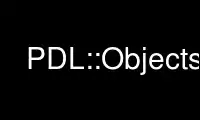
This is the command PDL::Objectsp that can be run in the OnWorks free hosting provider using one of our multiple free online workstations such as Ubuntu Online, Fedora Online, Windows online emulator or MAC OS online emulator
PROGRAM:
NAME
PDL::Objects -- Object-Orientation, what is it and how to exploit it
DESCRIPTION
This still needs to be written properly. [Also, is there a good reason we don't recommend
storing extra object data in the header hash?]
Inheritance
There are basically two reasons for subclassing piddles. The first is simply that you
want to be able to use your own routines like
$piddle->something()
but don't want to mess up the PDL namespace (a worthy goal, indeed!). The other is that
you wish to provide special handling of some functions or more information about the data
the piddle contains. In the first case, you can do with
package BAR;
@ISA=qw/PDL/;
sub foo {my($this) = @_; fiddle;}
package main;
$a = PDL::pdl(BAR,5);
$a->foo();
However, because a PDL object is an opaque reference to a C struct, it is not possible to
extend the PDL class by e.g. extra data via subclassing. To circumvent this problem
PerlDL has built-in support to extent the PDL class via the has-a relation for blessed
hashes. You can get the HAS-A behave like IS-A simply in that you assign the "PDL" object
to the attribute named PDL and redefine the method initialize().
package FOO;
@FOO::ISA = qw(PDL);
sub initialize {
my $class = shift;
my $self = {
creation_time => time(), # necessary extension :-)
PDL => null, # used to store PDL object
};
bless $self, $class;
}
All PDL constructors will call initialize() to make sure that your extensions are added by
all PDL constructors automatically. The "PDL" attribute is used by perlDL to store the
PDL object and all PDL methods use this attribute automatically if they are called with a
blessed hash reference instead of a PDL object (a blessed scalar).
Do remember that if you subclass a class that is subclassed from a piddle, you need to
call SUPER::initialize.
NEED STUFF ABOUT CODE REFs!!
Examples
You can find some simple examples of PDL subclassing in the PDL distribution test-case
files. Look in "t/subclass2.t", "t/subclass3.t", etc.
Output Auto-Creation and Subclassed Objects
For PDL Functions where the output is created and returned, PDL will either call the
subclassed object's "initialize" or "copy" method to create the output object. (See
PDL::Indexing for a discussion on Output Auto-Creation.) This behavior is summarized as
follows:
·
For Simple functions, defined as having a signature of
func( a(), [o]b() )
PDL will call $a->copy to create the output object.
In the spirit of the Perl philosophy of making Easy Things Easy, This behavior enables
PDL-subclassed objects to be written without having to overload the many simple PDL
functions in this category.
The file t/subclass4.t in the PDL Distribution tests for this behavior. See that file
for an example.
·
For other functions, PDL will call $class->initialize to create the output object. Where
$class is the class name of the first argument supplied to the function.
For these more complex cases, it is difficult to second-guess the subclassed object's
designer to know if a "copy" or a "initialize" is appropriate. So for these cases,
$class->initialize is called by default. If this is not appropriate for you, overload the
function in your subclass and do whatever is appropriate is the overloaded function's
code.
Use PDL::Objectsp online using onworks.net services
